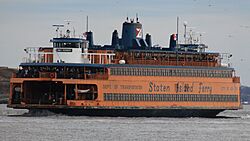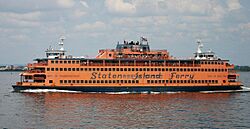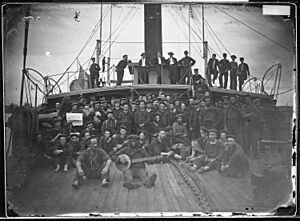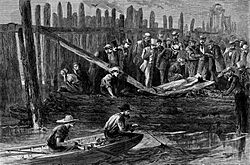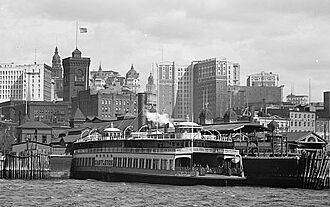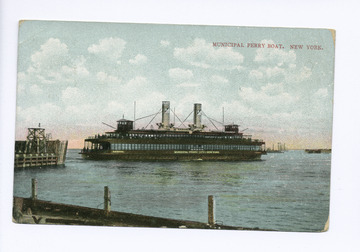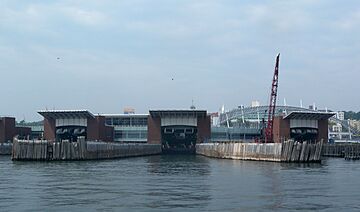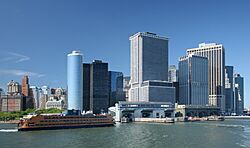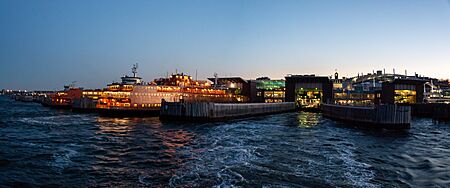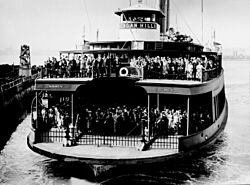Staten Island Ferry facts for kids
 |
|
| Locale | Staten Island and Manhattan, New York City |
|---|---|
| Waterway | Upper New York Bay |
| Transit type | Passenger ferry |
| Operator | New York City Department of Transportation |
| Began operation | 1817 |
| System length | 5.2 mi (8.4 km) |
| No. of lines | 1 |
| No. of vessels | 10 |
| No. of terminals | 2 (Whitehall, St. George) |
| Yearly ridership | 13,617,400 (2022) |
| Connections at Whitehall Terminal | |
| M15, M15 SBS, M20, M55, Downtown Connection | |
| Connections at St. George Terminal | |
| NYC Ferry SG Route | |
| S40, S42, S44, S46, S48, S51, S52, S61, S62, S66, S74, S76, S78 | |
The Staten Island Ferry is a free boat service for people. It is run by the New York City Department of Transportation. The ferry travels about 5.2 miles (8.4 km) across New York Harbor. It connects the New York City areas of Manhattan and Staten Island. Each trip takes about 25 minutes.
The ferry runs all day, every day. Boats leave every 15 to 20 minutes during busy times. At other times, they leave every 30 minutes. This ferry is the main way to travel between Staten Island and Manhattan by public transport. Other ferries exist, but this one is special because it is free. It has been free since 1997.
The ferry stops at two places. In Manhattan, it stops at Whitehall Terminal in Lower Manhattan. In Staten Island, it stops at St. George Terminal in St. George, Staten Island. At Whitehall, you can connect to the New York City Subway and many New York City Bus routes. At St. George, you can connect to the Staten Island Railway and many bus routes. If you use a MetroCard, you can transfer for free between the ferry and other public transport.
The Staten Island Ferry started in 1817. A company called Richmond Turnpike Company began a steamboat service. Later, in 1838, Cornelius Vanderbilt bought this company. Over time, different companies owned the ferry. In 1905, the City of New York took control. In the past, there were also ferry routes from Staten Island to Brooklyn. But these stopped by the 1960s as more people used cars. The ferry to Manhattan stayed popular.
The Staten Island Ferry is the busiest ferry route in the United States. It carries millions of passengers each year. Many people use it because there are not many other ways to get between Staten Island and Manhattan. Tourists also love the ferry. It offers great free views of New York Harbor and the Statue of Liberty. The ferry has also been seen in many movies.
Contents
A Look Back: The Ferry's Journey
Before the Ferry: Early Boats
Before Europeans arrived, the Lenape Native Americans used boats. They traveled on the waterways around what is now Staten Island and Manhattan. Later, in the 1700s, private people offered ferry services. They used small sailboats called "periaugers" to cross New York Harbor.
Starting the Ferry Service
Cornelius Vanderbilt began a ferry service in 1810. He was only 16 years old. He bought a boat called Swiftsure and carried passengers from Staten Island to Manhattan. People called him "Commodore" because he was so eager. During the War of 1812, Vanderbilt made money carrying goods. He bought more boats with his profits.
In 1817, the Richmond Turnpike Company started the first motorized ferry. It was a steamboat called Nautilus. This made travel much faster. Vanderbilt then sold his sailboats. He started working with steamboats in other parts of New York.
Vanderbilt bought control of the Richmond Turnpike Company in 1838. By the mid-1800s, there were three ferry companies. They all went between Manhattan and Staten Island. In 1853, these companies joined together. Vanderbilt sold his part of the ferry company for $600,000.
The new company was called the Staten Island and New York Ferry Company. They used single-ended boats at first. Later, they added double-ended boats. The Hunchback, built in 1852, was the first double-decked boat. During the American Civil War, the Union Army bought four of their boats. Only Hunchback survived the war.
The Railroad Takes Over
The Staten Island Railway (SIR) opened in 1860. It needed a good connection to the ferries. In 1864, Cornelius Vanderbilt bought the ferries again. This brought both the railroad and the ferries under one company. The railway took over the ferry operations in 1865.
On July 30, 1871, the ferryboat Westfield II had a boiler explosion. It was docked in Manhattan. Many people were hurt or died. This event caused problems for the railroad's money.
A Canadian businessman named Erastus Wiman wanted to improve Staten Island. He planned to combine all the ferry services into one terminal. This became the St. George Terminal, which opened in 1886. In 1883, Wiman's company took control of the SIR and its boats. The Baltimore and Ohio Railroad (B&O) then gained control in 1884. This allowed them to offer ferry service closer to Manhattan's public transport.
The City Takes Control
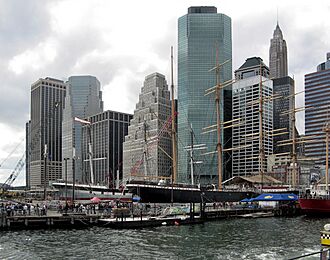
By the early 1900s, people on Staten Island were unhappy with the ferry service. They felt it was not safe. A major event happened on June 14, 1901. The ferryboat Northfield II was hit by another ferry. Northfield II sank quickly. Four or five people died.
After this, New York City decided to take over the ferry. In March 1903, the city decided to run two ferry routes from Staten Island. One would go to Manhattan. The other would go to Brooklyn. A law was passed in May 1903 allowing the city to buy the ferry. The city paid $3.2 million. This included money for five new boats. Each boat was named after one of the five boroughs of New York City.
The city took ownership of the ferry and its terminals on October 25, 1905. The new borough-named ferryboats began their first trips. The next year, the city also bought the five older B&O ships.
City Ownership and New Routes
Early 1900s to 1940s
The city started operating the ferry service from St. George to 39th Street in Brooklyn on November 1, 1906. This route mainly served factories in Sunset Park, Brooklyn. Three new, smaller boats were built for this route. Another route from St. George to 69th Street in Bay Ridge, Brooklyn, started in 1912. This was run by a private company.
New York City also ran a ferry from Battery Park to Stapleton, Staten Island starting in 1909. But this service stopped in 1913 because not many people used it. The city's ferry routes did not make a profit until 1915.
New boats were ordered in the 1920s. The President Roosevelt came in 1921, and the American Legion in 1926. In 1926, the boats changed from white to maroon paint. This color hid dirt better.
In the 1930s, new boats were added to both the Whitehall Street and 39th Street routes. The Dongan Hills class boats arrived from 1929 to 1931. The Mary Murray class boats arrived from 1937 to 1938.
The private company running the 69th Street ferry had problems. Their boats were old, and they faced competition. In 1939, they had to stop operations. Another company, Electric Ferries, took over.
Mid-1940s and 1950s
After World War II, the city wanted to rebuild the St. George Terminal. A fire in 1946 destroyed the ferry slips for the Whitehall route. The 39th Street ferry service was stopped so Whitehall ferries could use its slips. The new St. George Terminal was finished in 1951.
From 1950 to 1951, three new Merrell-class boats were built. These boats used more efficient engines. However, they soon became old-fashioned when even more powerful diesel-engine boats were introduced.
Around this time, many ferry services were closing. Bridges and tunnels were replacing them. The 69th Street ferry stopped running in 1964. This was because the Verrazzano-Narrows Bridge opened. But the ferry between St. George and Whitehall stayed open. It was still the only direct link between the two areas.
One Ferry Line Remains
1960s to 1990s
By 1967, the St. George-to-Whitehall route was the only ferry left in New York City. Other ferry routes started again in the 1980s. Night service on the Staten Island Ferry was stopped in 1975 due to money problems. It was brought back in the 1980s when two new boats were ordered. These boats, the Austen class, started service in 1986.
By the late 1980s, ferries were popular again. In 1997, a new, faster ferry route started. It went from St. George to East 34th Street in Midtown Manhattan.
However, in July 1997, the main Staten Island Ferry became free. This was part of a plan to make transfers easier with the MetroCard. Because the main ferry was free, fewer people paid for the Midtown ferry. The Midtown ferry stopped running in 1998. It did not start again until August 2021, when NYC Ferry began its St. George route.
2000s to Today
After the September 11 attacks in 2001, Staten Island ferryboats helped evacuate people. The ferry service was closed for a week. When it reopened, some ferries went to Bay Ridge because other transport was closed. In 2003, cars were no longer allowed on the ferry. Passengers also had to use the upper levels of the terminals to board.
In 2004, night and weekend service increased because more people were riding. In 2015, weekend and late-night trips became more frequent. In 2017, the lower levels of the terminals reopened. This helped reduce crowding on the boats.
In March 2020, during the coronavirus pandemic, ferry trips became less frequent. This was because fewer people were riding. Full service returned in August 2021. In 2024, plans were announced to reopen food stands on the ferryboats.
How the Ferry Works
The Staten Island Ferry runs all day, every day. Most of the time, a new ferry leaves every 30 minutes. During busy times, they leave every 15 to 20 minutes. The trip takes 25 minutes. In 2016, the ferry carried 23.9 million passengers.
The Ferry Route
<mapframe text="A map showing the route of the ferry through Upper New York Bay" width=250 height=250 zoom=12 latitude=40.6715 longitude=-74.0425> { "type": "FeatureCollection", "features": [ { "type": "Feature", "properties": {}, "geometry": { "type": "LineString", "coordinates": [ [ -74.01214599609375, 40.70042247927178 ], [ -74.0313720703125, 40.691572265436726 ], [ -74.05797958374023, 40.64834551665458 ], [ -74.07085418701172, 40.6430053297684 ] ] } } ] } </mapframe> In Manhattan, the ferry leaves from the Staten Island Ferry Whitehall Terminal. This is at the very tip of Manhattan, near the Battery. In Staten Island, boats leave from the St. George Ferry Terminal.
The ferry ride offers amazing views. You can see the Downtown Jersey City skyline and the Lower Manhattan skyline. You can also see the Statue of Liberty, Ellis Island, Governors Island, and the Verrazzano-Narrows Bridge. Because of these views, the ferry is a popular spot for filming movies. It has been in Working Girl, How to Lose a Guy in 10 Days, and Spider-Man: Homecoming.
In the past, ferries carried cars. But car transport was stopped after the September 11 attacks. Now, only bicycles are allowed. Cyclists must walk their bikes onto the boat. Bicycles must be stored in a special area on the ferry.
Ferry Terminals
Whitehall Terminal
The Whitehall Terminal in Manhattan has been rebuilt several times. The first terminal opened in 1903. It had a beautiful design. A fire in 1991 destroyed the old terminal. A temporary terminal was used while a new one was built.
A completely new and modern terminal opened in 2005. It was designed by architect Frederic Schwartz. The terminal connects to the New York City Subway and many buses and taxis.
St. George Terminal
The St. George Terminal in Staten Island was planned in the 1870s. It was built where Staten Island is closest to Manhattan. The terminal opened in 1886.
A large fire in 1946 destroyed the wooden ferry and train terminals. Three people died. A new, modern facility was built by the city. It opened in 1951. The terminal was renovated again in the 2000s. Today, St. George's direct connection between train and ferry is rare in the United States.
Ferry Fares
There is no charge to ride the Staten Island Ferry. However, if you want to make a round trip, you must get off the boat at each terminal. Then you need to re-enter the terminal building. This is to follow safety rules about how many people can be on the boat.
For most of the 1900s, the ferry cost only five cents. This was the same price as the New York City Subway. People even protested in 1882 when the fare was going to be raised to 10 cents.
The five-cent fare stayed the same for a long time, even as prices for other things went up. In 1970, the mayor suggested raising the fare to 25 cents. He said each ride cost 50 cents to operate. In 1975, the fare was finally raised to 25 cents for a round trip.
In 1990, the round-trip fare went up to 50 cents. Many people on Staten Island were upset. In 1993, this anger even helped lead to a vote for Staten Island to leave New York City.
In July 1997, the passenger fare was removed completely. This was part of the MTA's "one-city, one-fare" system. This system allowed for more free transfers between different types of public transport. Making the ferry free helped Staten Islanders have the same free transfer benefits as people in other parts of the city.
In 2014, a study looked at charging a fare for tourists but not for Staten Island residents. The study found that a $4 fare could bring in a lot of money. But the ferry remains free for everyone.
How Many People Ride
| Fiscal Year | Ridership (millions) |
Ref. |
|---|---|---|
| 2007 | 18.953 | |
| 2008 | 19.757 | |
| 2009 | 20.118 | |
| 2010 | 21.464 | |
| 2011 | 21.404 | |
| 2012 | 22.178 | |
| 2013 | 21.399 | |
| 2014 | 21.256 | |
| 2015 | 21.9 | |
| 2016 | 23.1 | |
| 2017 | 23.9 | |
| 2018 | 24.5 | |
| 2019 | 25.2 |
The number of people riding the ferry has changed over the years. In 1964, ridership was at its highest, with 27.5 million passengers. But it dropped to 22 million in 1965 after the Verrazzano-Narrows Bridge opened.
In the early 2000s, ridership was usually between 18 and 19 million. It went up to 21.8 million in 2006. Then it dropped a bit before rising again. By 2011, it was over 21 million.
In 2012, the ferry carried 22.18 million passengers. This was the highest number in many years. Ridership continued to grow in later years. In 2016, it reached 23.1 million passengers. In 2017, it was 23.9 million, setting a new record. By 2019, ridership increased to 25.2 million passengers.
As of 2016, the Staten Island Ferry is the busiest single ferry route in the United States. It is also the busiest ferry system in the world that only carries passengers.
The Ferry Fleet
Boats Used Today
There are ten ferry boats currently in service. They belong to four different groups, or "classes": Barberi, Austen, Molinari, and Ollis.
Barberi Class

The Barberi class includes the MV Andrew J. Barberi and MV Samuel I. Newhouse. They were built in 1981 and 1982. Each boat has a crew of 15. They can carry 6,000 passengers but no cars. These boats are 310 feet (94 m) long and 69 feet 10 inches (21.29 m) wide. They were the largest licensed ferries in the world when they were built.
The Andrew J. Barberi is named after a high school football coach. The Samuel I. Newhouse is named after a newspaper publisher.
Austen Class
The Austen class has the MV Alice Austen and MV John A. Noble. They were built in 1986. People sometimes call them "the Little Boats." Each boat has a crew of nine. They carry 1,280 passengers but no cars. These boats are 207 feet (63 m) long and 40 feet (12 m) wide.
Austen-class boats usually run late at night and early in the morning. This is when fewer people are riding. The Alice Austen or John A. Noble might be changed to use liquefied natural gas (LNG) for fuel. This would help save fuel and reduce pollution.
Molinari Class
The Molinari class includes the MV Guy V. Molinari, MV Sen. John J. Marchi, and MV Spirit of America. Each boat has a crew of 16. They can carry up to 4,427 passengers and 30 vehicles. These boats are 310 feet (94 m) long and 70 feet (21 m) wide. They were designed to look like classic New York ferryboats.
The lead boat is named after Guy Molinari, a former U.S. Representative and Staten Island borough president. The second ferry is named for State Senator John J. Marchi. The Spirit of America was meant to celebrate 100 years of city ferry ownership. These ferries have had some mechanical problems since they started service.
Ollis Class
The John F. Kennedy, Samuel I. Newhouse, and Andrew J. Barberi boats are being replaced. Three new 310 feet (94 m) vessels are taking their place. They are named SSG Michael H. Ollis, Sandy Ground, and Dorothy Day. The Ollis class is named after US Army Staff Sgt. Michael Ollis from Staten Island. He died while serving in Afghanistan.
The first new boat, MV SSG Michael H. Ollis, started service on February 14, 2022. MV Sandy Ground followed on June 17, 2022. The last ferry, MV "Dorothy Day," began service on April 28, 2023.
Older Ferry Boats
Many ferry classes bought by the city have been retired. The first city-commissioned boats in 1905 were named after the five boroughs: Bronx, Brooklyn, Manhattan, Queens, and Richmond. All of these boats were retired by the 1940s.
The next class, built for the Brooklyn line, included Gowanus, Bay Ridge, and Nassau. These were smaller boats and were all sold by 1940.
Later boats included Mayor Gaynor (1914), President Roosevelt (1922), and the first American Legion (1926). These boats had different sizes and engines. Mayor Gaynor was taken apart in 1951. The others were scrapped later.
In 1923, three more boats were built: William Randolph Hearst, Rodman Wanamaker, and George W. Loft. These boats were named after important New York City businessmen. They were mostly used on the 39th Street route and were out of service by 1954.
Another class of boats, delivered from 1929 to 1931, included Dongan Hills, Tompkinsville, and Knickerbocker. These boats were similar in size. They were all sold or scrapped by the late 1960s.
The Miss New York class, including Miss New York, Gold Star Mother, and Mary Murray, arrived in 1938. These boats were retired in the late 1960s and 1970s. Some were sold, and one sank.
The sixth class of ferryboats, Cornelius G. Kolff, Pvt. Joseph F. Merrell, and Verrazzano, started service in 1951. These boats were larger. Some of these boats were even used as temporary jails at Rikers Island in the 1980s. They were scrapped in 2004.
The Kennedy class included MV John F. Kennedy, the second MV American Legion, and MV The Gov. Herbert H. Lehman. They were delivered in 1965. These boats could carry both passengers and cars. Most of the Kennedy class boats have been scrapped. The John F. Kennedy was the last of its class in service. It retired in 2021 and was sold in 2022.
Ferry Incidents
Early 1900s Incidents
In November 1910, the ferryboat Nassau ran aground in heavy fog. Most passengers got off safely. In 1921, the ferryboat Mayor Gaynor also ran aground in fog. This boat was involved in two more crashes in 1929 and 1930, hitting the Whitehall ferry slip.
Later 1900s Incidents
In January 1953, four ferry accidents happened in New York Harbor due to heavy fog. In one, the Gold Star crashed into a freighter, hurting 13 people. In 1958, the Dongan Hills was hit by a tanker, injuring 15. In 1959, the Cornelius G. Kolff hit a ferry slip, injuring 14.
In 1960, a small explosion happened on a ferry near the Statue of Liberty. No one was hurt.
In 1978, the American Legion crashed into a seawall in thick fog. 173 people were injured. In 1981, the same boat crashed into a Norwegian freighter in fog. 71 passengers were hurt.
In 1986, a man attacked passengers on the Samuel I. Newhouse. Two people died, and nine were injured.
In 1995, the Andrew J. Barberi hit its slip due to a mechanical problem. Several people were injured. In 1997, a car drove off the John F. Kennedy ferry while docking. The driver and a deckhand were slightly hurt.
21st Century Incidents
On October 15, 2003, the Andrew J. Barberi crashed into a pier. This happened at the St. George terminal. Eleven people died, and many were seriously injured. The crash caused a large hole in the boat. This led to an investigation into ferry safety. The ferryboat returned to service in 2004.
The St. George terminal also saw two smaller crashes. In 2009, the Sen. John J. Marchi lost power and hit a pier. 15 people had minor injuries. In 2010, the Andrew J. Barberi had a problem with its reverse thrust. It hit the dock, injuring 37 passengers. In December 2022, several people were injured when a fire broke out on the Sandy Ground ferry.
See also
 In Spanish: Ferry de Staten Island para niños
In Spanish: Ferry de Staten Island para niños
- Staten Island Ferry Disaster Memorial Museum, a memorial sculpture commemorating a fake giant-octopus attack on the Staten Island Ferry
- Other ferry systems in the New York City area:
- NYC Ferry
- SeaStreak
- New York Water Taxi
- NY Waterway


